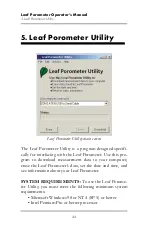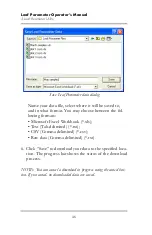
Leaf Porometer Operator’s Manual
6. Leaf Porometer Theory
57
6. Leaf Porometer Theory
Stomatal Conductance
By definition, stomatal conductance is the measure of the
rate of passage of carbon dioxide (CO
2
) or water vapor
through the stomata of a leaf. Stomata are small pores on
the top and bottom of a leaf that are responsible for taking
in and expelling CO
2
and moisture from and to the outside
air. The Leaf Porometer measures the rate at which this
happens.
How the Leaf Porometer Works
The Leaf Porometer measures the stomatal conductance of
leaves by putting the conductance of the leaf in series with
two known conductance elements. By measuring the humidity
difference across one of the known conductance elements,
the water vapor flux is known. The conductance of the leaf
can be calculated from these variables.
We know the humidity at three places: inside the leaf, and at
both of the humidity sensors. The Leaf Porometer effectively
calculates the resistance between the inside and outside of
the leaf: the stomatal conductance. Resistance is measured
between the leaf and the first humidity sensor, and the first
and second sensors. The following diagram schematically
illustrates this:
















































